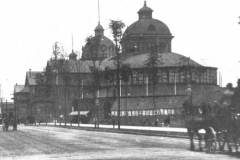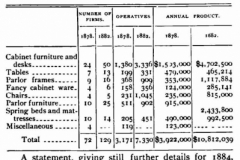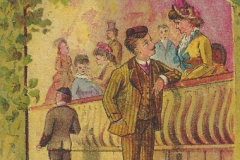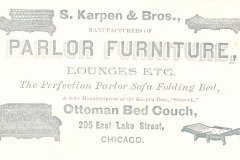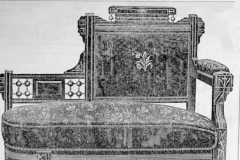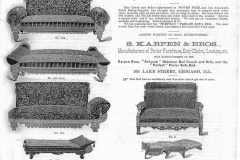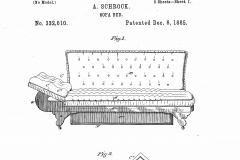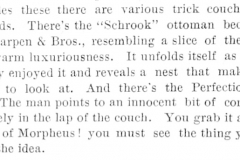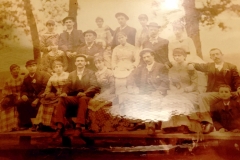First Steps: 1885-1886
As each of my brothers finished school, he was taken into the business as an apprentice, learning it from the lumber yard to the shipping room door. In time the whole nine of us worked together, all of us knew all phases of it intimately. —Solomon Karpen in Neil Clark, “How Nine Brothers Built Up a $10,000,000 Business,” Forbes, August 1, 1926, 10.
Another important avenue for marketing was participation in manufacturers’ exhibitions where dealers, other manufacturers, and the public could view their goods. While a company would have to pay to participate, early on Adolph realized the usefulness of this marketing tool to introduce the Karpen name and products to a broader audience.
Furniture buyers from retail stores traveled to Chicago for the exhibitions and to visit manufacturers’ salesrooms. All the railroads coming into Chicago offered their patrons discount tickets which encouraged many people to come who never had come before and others to come again.[2] The huge geographic distances across the United States caused buyers to choose where they shopped for merchandise to stock their stores. The Chicago market did not attract buyers from the east coast because those buyers could easily visit the New York and Boston markets. Rather buyers coming into Chicago traveled from the West, Midwest and South. [3][4] These buyers would also attend furniture exhibitions held in Grand Rapids, Michigan and/or Cincinnati, Ohio which were more established and, in the case of Grand Rapids, which had larger furniture manufacturing centers. In addition, according to Adolph, “the primary object of expositions was the education of the people. By placing before the eyes of the people the highest development of social, artistic, industrial and scientific progress, production, education, art and science were immensely stimulated.” [5]
After only three years in business, Karpen Bros. was among the prominent exhibitors at the Industrial Exhibition held in Chicago in 1884.[6] The next year, the State Industrial Exposition was held for six weeks.[7] “S. Karpen Bros. had a “fine display at the exposition, consisting of their well-known Perfection parlor folding bed.”[8]
These exhibitions also marked Chicago’s growing importance as a furniture manufacturing center. A new furniture trade paper, The American Furniture Gazette, began publishing in Chicago and highlighted Chicago companies and its market. In fall 1884, it published a special edition, The Furniture Interests of Chicago.[9]
New Opportunities
Solomon sought new opportunities to expand the business: acquiring the rights and patents for new product lines was an effective course for the company. In the nineteenth century, inventors were obtaining patents for all types of furniture, but did not have the financial or manufacturing means to bring their ideas to fruition. Solomon obtained a few of these rights and patents and began manufacturing the “Perfection” Parlor Folding Bed, under the Burnitz Patents and the “Bridal” sofa lounge recently invented and put in the market by N. Jacobson, of Chicago.[11] “The demand for the Jacobson “bridal sofa” grew rapidly, and orders from prospective brides were numerous.”[12]
In a large advertisement in The Trade Bureau in 1883, “S. Karpen & Bros., Manufacturers of Parlor Furniture, Lounges, etc., 204 East Lake Street, Chicago, Ill.” had announced that it was the manufacturer, under the Burnitz Patents, of the “Perfection” Parlor Folding Bed for the West and Northwest.[13][14] The prices ranged from “only $16.20” to “Ramie or silk- $18; Hair cloth or wool terry- $20; Spun silk or cashmere- $22.50.”[15]
While the Karpen factory produced all types of upholstered furniture, it focused its advertising on the secure and ever-expanding marketing niche—the folding bed. In the 1880s families were moving to the cities from the farmlands, and recent immigrants were settling in the cities where the economic growth could offer all levels of employment. These recent city-dwellers, and those people who had lived in the cities for decades, were always cramped for space in the small apartments they could afford. A fold-away bed was almost a necessity. The Perfection Parlor Sofa Bed was “only four feet wide when closed, but makes a full-sized Bed when open.” [16] A reporter for The Trade Bureau supported those efforts when he wrote, “the folding bed business is good. Prices are good, and the public evidently appreciate the folding bed.”[17]
Karpen Bros.’ continued success necessitated another expansion in 1885. It moved to a large building[19] at 205 West Lake St. [20][21][22] where it occupied two loft spaces on four floors.[23][24] William “Will,” 17, joined the company as bookkeeper.[25]
Karpen Bros. used chromolithograph advertising trade cards to give out information about its new location. These advertising cards were very popular in the 1880s. Whimsical and attractively attired women usually adorned the front of the cards.
For the first time, the company received a mention in the important furniture trade journal, The American Cabinet Maker and Upholsterer: “S. Karpen & Bros. will move from 204 Lake street, their present location, to a more commodious stand on the same street, nearly opposite the old place.”[28][29] A few months later, the reporter wrote, “S. Karpen & Bros. are having splendid trade in upholstered goods. They are also manufacturers of the “Perfection” sofa folding bed lounge, of which they are the sole agents for the west and northwest. By watching the columns of the American Cabinet Maker you will see a fine piece of furniture of their make.”[30] This item coincided with Karpen Bros.’ first advertisement in that publication where it was listed under the Chicago “Index to Advertisements” as “Karpen, S. & Bros.—Upholstered goods.”[31] The advertisement, measuring six inches square, pictured an ornate piece with a style number beneath it.
In subsequent months, American Cabinet Maker and Upholsterer took further notice of the company. Its reporter wrote that S. Karpen & Bros. “are now able to attend to their increasing trade with greater facility;” [32] “are doing a good business in parlor furniture;”[33] “report a good trade in their line; especially they have had a good season in their “Perfection” sofa bed;”[34] and “are having about all they can do and are now behind on their orders. This firm manufacture has a very fine line of upholstered goods.”[35]
“S. Karpen & Bros. have about all they can do filling city orders, but still they have a rapidly increasing outside trade.”[36] The importance of the potential market outside of the Chicago area led Mike, at 20, to leave his job in the factory to become the first “Middle States” salesman; he covered Iowa, Wisconsin, the Dakotas, Minnesota, Illinois, Kansas and Missouri.”[37] Its advertisements also appealed for “Agents wanted to sell everywhere!” [38] In seeking to expand its market, Karpen Bros. offered guarantees and concessions in its advertisements: “Send us a sample order and if not satisfactory return. We will pay all expenses, freight, packing and unpacking. Frames shipped K.D. [knocked down].” [39]
With a larger factory, Karpen Bros. added to its line of sofa-beds with the “Schrock” patent bed lounge. [40] In 1885 Amos Schrock of Chicago had patented a sofa-bed with special features for the sofa-back and head supports.[41] According to its advertising copy, “This Couch and Sofa is upholstered on woven wire and has Adjustable Spiral Spring Support; has wrought iron automatic legs to support back when open; is spring edge on seat and back; has no ridge in center, has loose drawer for bed clothes; and will sell better than any other bed-couch in the market….{Hand pointing} This Bed has no machinery and therefore cannot get out of order.”[42]
Karpen Bros. featured the “Schrock” and “Perfection” bed lounges in its exhibit at the Industrial Exposition, and the reaction of the trade reporter was effusive:
1886
A major event in the course of Karpen Bros. occurred when, in 1886, after about a year and a half in the drug store business, Adolph returned to the business. The company expanded its marketing strategy. Adolph traveled to New York City where he made arrangements for the opening of “a branch house.”[43] He found salesrooms for the sale of their lounges.[44] “The celebrated ‘Schrock’ Ottoman bed will be the only specialty introduced in the east.” [45]
Labor issues came to the forefront in April 1886 throughout the country. When the Upholsterers’ Union of Chicago demanded an increase of twenty percent on piece-work prices and that eight hours should be considered a day’s work at ten hours’ pay, Karpen Bros. joined with almost all the Chicago companies to form the Chicago Parlor Furniture Manufacturers Association to fight those demands. The companies were convinced that acceding to the 1,000 member union would “kill business in Chicago.”[46] A few weeks later, however, Karpen Bros. and other firms accepted the Union’s demands.[47]
As 1886 came to a close, business was looking good.
- Furniture Journal, Sept. 1917, 89. ↑
- Trade Bureau, Sept. 6, 1884, 20. ↑
- American Cabinet Maker and Upholsterer, Sept. 12, 1885, 13. ↑
- American Cabinet Maker and Upholsterer, Sept. 19, 1885, 15. ↑
- American Cabinet Maker and Upholsterer, May 25, 1885, 16. ↑
- Trade Bureau, Sept. 22, 1883, 20. ↑
- Trade Bureau, Sept. 6, 1884, 20. ↑
- Trade Bureau, Sept. 27, 1884, 16. ↑
- “The Furniture Interests of Chicago,” American Furniture Gazette, Fall Extra, 1884). ↑
- Trade Bureau, Nov. 3, 1883, 20. ↑
- Trade Bureau, Oct. 3, 1884, 19. ↑
- Trade Bureau, Oct. 10 1885, 27. ↑
- Trade Bureau, Nov. 3, 1883, 20. ↑
- ↑
- American Furniture Gazette, Fall 1884, xxv. ↑
- Trade Bureau, Oct. 16, 1886, 14; Nov. 13, 1886, 25; Nov. 27, 1886, 12; Jan. 1, 1887, 23. ↑
- Trade Bureau, Sept. 22, 1883, 20. ↑
- Advertisement, Trade Bureau, Oct. 3, 1885, 38. ↑
- Trade Bureau, Mar. 14, 1885, 23. ↑
- Lakeside Directory of Chicago, 1885, 747. ↑
- American Cabinet Maker and Upholsterer, Aug. 13, 1887, 23-4. ↑
- American Cabinet Maker and Upholsterer, July 28, 1894, 20. ↑
- Chicago Furniture Manufacturers Association, The Story of Karpen. (Chicago: Chicago Furniture Manufacturers Association, August 26, 1930.)↑
- Solomon Karpen in, Carl Saunders, “They Called Us Crazy, but ─,”[An Interview with Sam Karpen] Furniture Manufacturer (September, 1930), [3]. (reprinted by S. Karpen & Bros, “Karpen Celebrates Half Century of Service.”) ↑
- Lakeside Directory of Chicago, 1884, 717. ↑
- American Cabinet Maker and Upholsterer, Oct. 3, 1885, 9; Oct. 31, 1885, 10. ↑
- American Cabinet Maker and Upholsterer, Sept. 19, 1885, 20; Sept. 26, 1885, 15. ↑
- American Cabinet Maker and Upholsterer, Feb. 21, 1885, 12. ↑
- Trade Bureau, Apr. 18, 1885, 18. ↑
- American Cabinet Maker and Upholsterer, Sept. 19, 1885, 15. ↑
- American Cabinet Maker and Upholsterer, Sept. 26, 1885, 18. ↑
- American Cabinet Maker and Upholsterer, June 6, 1885, 4. ↑
- American Cabinet Maker and Upholsterer, June 13, 1885, 14. ↑
- American Cabinet Maker and Upholsterer, Aug. 29, 1885, 15. ↑
- American Cabinet Maker and Upholsterer, Sept. 12, 1885, 13. ↑
- American Cabinet Maker and Upholsterer, Oct. 10, 1885, 18. ↑
- “Funeral Today on Coast for Mike Karpen,” Retailing Daily, New York, July 3, 1950, 7. ↑
- Trade Bureau, Oct. 16 1886, 14.; Nov. 13, 1886, 25; Nov. 27, 1886, 12; Jan. 1, 1887, 23. ↑
- Trade Bureau, Oct. 16, 1886, 14; Nov. 13, 1886, 25; Nov. 27, 1886, 12; Jan. 1, 1887, 23. ↑
- Trade Bureau, Nov. 13, 1886. ↑
- U.S. Patent # 332,010, Dec. 8, 1885 by A. Schrock. ↑
- Trade Bureau, Oct. 16, 1886, 14; Nov. 13, 1886, 25; Nov. 27, 1886, 12; Jan. 1, 1887, 23. ↑
- American Cabinet Maker and Upholsterer, Sept. 18, 1886, 15. ↑
- Trade Bureau, Oct. 9, 1886, 17. ↑
- American Cabinet Maker and Upholsterer, Sept. 25, 1886, 12. ↑
- Daily Inter-Ocean (Chicago), Apr.30, 1866. ↑
- Chicago Daily Tribune, May 9, 1886. ↑
